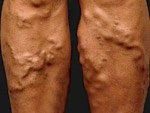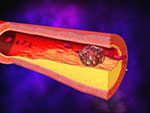Contact Us Today
For all enquiries you can email us at info@hunterveinclinic.com.au or call
ph: 4933 0431
Venous Disorders
A variety of problems can arise from disordered venous function. The following is a brief overview, but more information can be given by Dr Hunter during your consultation. Please remember that not all conditions are experienced by all patients and most early cases of varicose veins are not associated with serious problems! In general it is better to treat varicose veins before complications arise as better results are obtained.
Spider Veins
Spider veins consist of small dilated blood vessels lying just beneath the skin surface. They may appear red or blue and be single or in groups. They may be associated with symptoms such as aching or itching, or occasionally they may bleed.
Varicose Veins

Varicose veins are enlarged, dilated, tortuous veins. They appear raised and lumpy and may be blue, purple or discoloured. Symptoms include aching, throbbing, swelling and cosmetic concerns.
Thrombosis
Thrombosis consists of a blood clot occurring in a vein.
There are two different types of thrombosis which occur in the legs:
Deep Venous Thrombosis (DVT) involves obstruction of a deep vein by a blood clot. It is a potentially serious condition and symptoms include pain, swelling, heat, and redness of the affected leg. Predisposing factors include periods of prolonged immobilisation such as air travel, long trips, plaster casts on the leg following fractures, operations and hospitalisations, cancer and disorders of blood clotting (thrombophilia). A piece of the blood clot may break off and travel to the lungs (pulmonary embolism). Rarely this may be fatal and always warrants emergency medical attention. The clot may cause damage to the valves in the deep veins of the leg leading to increased pressure, swelling, discolouration, hardening of the skin and increased risk of ulceration. Superficial varicose veins may subsequently develop in the leg.
Superficial Venous Thrombosis (also termed phlebitis or superficial thrombophlebitis) involves a clot forming in a superficial vein, usually a varicose vein. The vein feels hard and is tender, hot and red. It is a painful condition but not usually serious. It is usually an indication that the varicose veins should be treated.
Post-thrombotic Syndrome
This condition may follow a deep venous thrombosis resulting from damage to deep venous valves as mentioned above. Symptoms include swelling, aching, discolouration and hardening of the skin particularly around the ankles. Varicose and spider veins may develop, and there is an increased risk of infection such as cellulitis or ulceration of the skin.
Chronic Venous Insufficiency (CVI)
Swelling, discolouration of the skin, hardening of the tissues of the lower leg, varicose and spider veins, increased risk of ulceration or cellulitis are all associated with this condition. It may be the end result of severe varicose veins or occur as a result of deep venous insufficiency. Occasionally it may result from obesity or extreme immobility.
Venous Hypertension
Venous hypertension refers to increased pressure occurring in the veins due to venous incompetence (deep or superficial) or other factors which restrict venous return. This is really the same as chronic venous sufficiency (see above).
Venous Stasis Ulcer
This may occur with CVI resulting from a chronically insufficient supply of oxygen and nutrients to tissues and it usually occurs in the lower leg or ankle region. Often these ulcers are painful and very slow to heal. They cause significant morbidity and a huge cost to the health care system. Early treatment of varicose veins is recommended to avoid this condition as the skin damage and changes may be irreversible.
Pregnancy and Varicose Veins
The venous system is subject to extra strain during pregnancy. The veins have to transport an increased blood volume and the higher concentration of the hormone progesterone leads to dilatation of the veins. The enlarging uterus puts additional pressure on the veins in the pelvis that drain blood from the leg. This can lead to the formation of varicose veins in the legs and also around the vulval area. These veins usually improve after delivery but tend to gradually worsen during subsequent pregnancy. It is recommended to have treatment between pregnancies to reduce symptoms and avoid complications such as phlebitis. There is an increased risk of phlebitis occurring particularly in the immediate post partum period. Although treatment is not usually recommended during pregnancy, a good compression stocking will reduce the discomfort experienced.
Lymphoedema
Delicate lymphatic channels return fluid from the tissues to the vascular system. If the lymphatics become faulty or damaged, fluid accumulation and fatty deposits will occur. This commonly manifests in the lower limbs and is often found in association with varicose veins. Damage to the lymphatics may be the result of surgery, radiotherapy, infection, venous hypertension, hereditary factors and obesity.
Congenital Malformations
There are a number of congenital abnormalities which may occur involving the leg veins. These are rare and may include such conditions as absence of the deep venous system or arterio-venous malformations or angiomas. Further information can be supplied by Dr Hunter if required.


